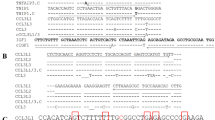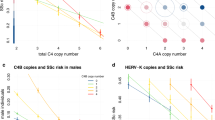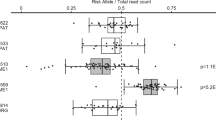Abstract
CTLA-4, expressed mainly on activated T cells, helps maintain, through its inhibitory function, immune-system homeostasis. Polymorphisms in the CTLA-4 gene (CTLA4) are known to be important in several autoimmune diseases, including multiple sclerosis (MS). Here, we have performed genotyping for CTLA4 polymorphisms, and investigated expression by peripheral blood mononuclear cells of CTLA-4 mRNA and protein, in patients with MS and myasthenia gravis and in healthy controls. Expression levels for mRNA and protein were similar in the patient and control groups; however, there was a clear relationship between genotype and CTLA-4 expression. Specifically, individuals carrying thymine at position −318 of the CTLA4 promoter (T−318) and homozygous for adenine at position 49 in exon 1 showed significantly increased expression both of cell-surface CTLA-4 after cellular stimulation and of CTLA-4 mRNA in non-stimulated cells. The association was seen most clearly for unsorted CD3+ cells and was absent in the CD8+ subset. The T−318 allele has been shown to be negatively associated with susceptibility to MS in an earlier study by our group. Thus, we propose that the susceptibility-influencing role of CTLA4 in MS may be related to genotypically conditioned promoter function, whereby high gene expression may decrease the risk of disease.
This is a preview of subscription content, access via your institution
Access options
Subscribe to this journal
Receive 6 digital issues and online access to articles
$119.00 per year
only $19.83 per issue
Buy this article
- Purchase on Springer Link
- Instant access to full article PDF
Prices may be subject to local taxes which are calculated during checkout
Similar content being viewed by others
References
Martino G, Hartung HP Immunopathogenesis of multiple sclerosis: the role of T cells Curr Opin Neurol 1999 12 309–321
Karandikar NJ, Vanderlugt CL, Walunas TL, Miller SD, Bluestone JA CTLA-4: a negative regulator of autoimmune disease J Exp Med 1996 184 783–788
Tivol EA, Borriello F, Schweitzer AN, Lynch WP, Bluestone AJ, Sharpe AH Los of CTLA-4 leads to massive lymphoproliferation and fatal multiorgan tissue destruction, revealing a critical negative regulatory role of CTLA-4 Immunity 1995 3 541–547
Carreno BM, Bennett F, Chau TA et al CTLA-4 (CD152) can inhibit T cell activation by two different mechanisms depending on its level of cell surface expression J Immunol 2000 165 1352–1356
Brunet JF, Denizot F, Luciani MF, Roux-Dosseto M, Suzan M, Mattei MG A new member of the immunoglobulin superfamily – CTLA-4 Nature 1987 328 267–270
Harper K, Balzano C, Rouvier E, Mattei MG, Luciani MF, Golstein P CTLA-4 and CD28 activated lymphocyte molecules are closely related in both mouse and human as to sequence, message expression, gene structure, and chromosomal location J Immunol 1991 147 1037–1044
Linsley PS, Greene JL, Tan P et al Coexpression and functional cooperation of CTLA-4 and CD28 on activated T lymphocytes J Exp Med 1992 176 1595–1604
Kuiper HM, Brouwer M, Linsley PS, van Lier RA Activated T cells can induce high levels of CTLA-4 expression on B cells J Immunol 1995 155 1776–1783
Donner H, Rau H, Walfish PG et al CTLA-4 alanine-17 confers genetic susceptibility to Graves’ disease and to type 1 diabetes mellitus J Clin Endocrinol Metab 1997 82 143–146
Marron MP, Raffel LJ, Garchon HJ et al Insulin-dependent diabetes mellitus (IDDM) is associated with CTLA4 polymorphisms in multiple ethnic groups Hum Mol Genet 1997 6 1275–1282
Yanagawa T, Hidaka Y, Guimaraes V, Soliman M, DeGroot LJ CTLA-4 gene polymorphism associated with Graves’ disease in a Caucasian population J Clin Endocrinol Metab 1995 80 41–45
Ligers A, Xu C, Saarinen S, Hillert J, Olerup O The CTLA-4 gene is associated with multiple sclerosis J Neuroimmunol 1999 97 182–190
Harbo HF, Celius EG, Vartdal F, Spurkland A CTLA-4 promoter and exon 1 dimorphisms in multiple sclerosis Tissue Antigens 1999 53 106–110
Heward JM, Allahabadia A, Carr-Smith J et al No evidence for allelic association of a human CTLA-4 promoter polymorphism with autoimmune thyroid disease in either population-based case-control or family-based studies Clin Endocrinol 1998 49 331–334
Seidl C, Donner H, Fischer B et al CTLA4 codon 17 dimorphism in patients with rheumatoid arthritis Tissue Antigens 1998 51 62–66
Vandenborre K, Delabie J, Boogaerts MA et al Human CTLA-4 is expressed in situ on T lymhocytes in germinal centres, in cutaneous graft-versus host disease, and in Hodgkins disease Am J Pathol 1998 152 963–973
Liu MF, Liu HS, Wang CR, Lei HY Expression of CTLA-4 molecule in peripheral blood T lymphocytes from patients with systemic lupus erythematosus J Clin Immunol 1998 18 392–398
Liu MF, Yang CY, Li JS, Lai KA, Chao SC, Lei HY Increased expression of down-regulatory CTLA-4 molecule on T lymphocytes from rheumatoid synovial compartment Scand J Immunol 1999 50 68–72
Mena E, Rohowsky-Kochan C Expression of costimulatory molecules on peripheral blood mononuclear cells in multiple sclerosis Acta Neurol Scand 1999 100 92–96
Magistrelli G, Jeannin P, Herbault N et al A soluble form of CTLA-4 generated by alternative splicing is expressed by non stimulated human T cells Eur J Immunol 1999 29 3596–3602
Oaks MK, Hallett KM, Penwell RT, Stauber EC, Warren SJ, Tector AJ A native soluble form of CTLA-4 Cell Immunol 2000 201 144–153
Perkins D, Wang Z, Donovan C et al Regulation of CTLA-4 expression during T cell activation J Immunol 1996 156 4154–4159
Kouki T, Sawai Y, Gardine CA, Fisfalen ME, Alegre ML, DeGroot LJ CTLA-4 gene polymorphism at position 49 in exon 1 reduces the inhibitory function of CTLA-4 and contributes to the pathogenesis of Graves’ disease J Immunol 2000 165 6606–6611
Takahashi T, Tagami T, Yamazaki S et al Immunologic self-tolerance maintained by CD25(+)CD4(+) regulatory T cells constitutively expressing cytotoxic T lymphocyte-associated antigen 4 J Exp Med 2000 192 303–310
Read S, Malmstrom V, Powrie F Cytotoxic T lymphocyte-associated antigen 4 plays an essential role in the function of CD25(+)CD4(+) regulatory cells that control intestinal inflammation J Exp Med 2000 192 295–302
Leung HT, Bradshaw J, Cleaveland JS, Linsley PS Cytotoxic T lymphocyte-associated molecule-4, a high avidity receptor for CD80 and CD86, contains an intracellular localization motif in its cytoplasmic tail J Biol Chem 1995 270 25107–25114
Schneider H, Martin M, Agarraberes FA et al Cytolytic T lymphocyte-associated antigen-4 and the TCRζ/CD3 complex, but not CD28, interact with clathrin adaptor complexes AP-1 and AP-2 J Immunol 1999 163 1868–1879
Alegre ML, Shiels H, Thompson CB, Gajeuski TF Expression and function of CTLA-4 in Th1 and Th2 cells J Immunol 1998 161 3347–3356
Chambers CA, Kuhns MS, Allison JP Cytotoxic T lymphocyte antigen-4 (CTLA-4) regulates primary and secondary peptide-specific CD4+ T cell responses Proc Natl Acad Sci USA 1999 96 8603–8608
Sun D, Ben-Nun A, Wekerle H Regulatory circuits in autoimmunity: recruitment of counter-regulatory CD8+ T cells by encephalitogenic CD4+ T line cells Eur J Immunol 1988 18 1993–1999
Braun J, Donner H, Siegmund T, Walfish PG, Usadel KH, Badenhoop K CTLA-4 promoter variants in patients with Graves’ disease and Hashimoto’s thyroiditis Tissue Antigens 1998 51 563–566
Park YJ, Chung HK, Park DJ et al Polymorphism in the promoter and exon 1 of the cytotoxic T lymphocyte antigen-4 gene associated with autoimmune thyroid disease in Koreans Thyroid 2000 10 453–459
Krummel MF, Allison PJ CTLA-4 engagement inhibits IL-2 accumulation and cell cycle progression upon activation of resting T cells J Exp Med 1996 183 2533–2540
Chen W, Jin W, Wahl SM Engagement of cytotoxic T lymphocyte-associated antigen 4 (CTLA-4) induces transforming growth factor-β (TGF-β) production by murine CD4(+) T cells J Exp Med 1998 188 1849–1857
Bachmann MF, Köhler G, Ecabert B, Mak TW, Kopf M Cutting edge: lymphoproliferative disease in the absence of CTLA-4 is not T cell autonomous J Immunol 1999 163 1128–1131
Gribben JG, Freeman GJ, Boussiotis VA et al CTLA4 mediates antigen-specific apoptosis of human T cells Proc Natl Acad Sci USA 1995 92 811–815
Poser CM, Paty DW, Scheinberg L et al New diagnostic criteria for multiple sclerosis: guidelines for research protocols Ann of Neurol 1983 13 227–231
Huang W-X, Huang P, Link H, Hillert J Cytokine analysis in multiple clerosis by competitive RT-PCR: A decreased expression of IL-10 and an increased expression of TNF-α in chronic progression Mult Scler 1999 5 342–348
Huang W-X, Huang P, Fredrikson S, Pirskanen R, Hillert J Decreased mRNA expression of TNF-α and IL-10 in non-stimulated peripheral blood mononuclear cells in myasthenia gravis Eur J Neurol 2000 7 195–202
Olerup O, Aldener A, Fogdell A HLA-DQB1 and -DQA1 typing by PCR amplification with sequence-specific primers (PCR-SSP) in 2 hours Tissue Antigens 1993 41 119–134
Reed PW, Davies JL, Copeman JB et al Chromosome-specific microsatellite sets for fluorescence-based, semi-automatic genome mapping Nat Genet 1994 7 390–395
Author information
Authors and Affiliations
Corresponding author
Additional information
This study was supported by grants from the Swedish Medical Research Council (project numbers 11023 and 11220), the Society for the Neurologically Disabled, the Sigurd and Elsa Goljes Minne Foundation, Karolinska Institutet, the Magn. Bergvall Foundation, the Åke Wiberg Foundation, the Bibbi and Nils Jensen Foundation and the Marcus Borgström Foundation.
Rights and permissions
About this article
Cite this article
Ligers, A., Teleshova, N., Masterman, T. et al. CTLA-4 gene expression is influenced by promoter and exon 1 polymorphisms . Genes Immun 2, 145–152 (2001). https://doi.org/10.1038/sj.gene.6363752
Received:
Revised:
Accepted:
Published:
Issue Date:
DOI: https://doi.org/10.1038/sj.gene.6363752
Keywords
This article is cited by
-
Screening for phenotypic outliers identifies an unusually low concentration of a β-lactoglobulin B protein isoform in bovine milk caused by a synonymous SNP
Genetics Selection Evolution (2022)
-
Risk factors for antibiotic resistance and mortality in patients with bloodstream infection of Escherichia coli
European Journal of Clinical Microbiology & Infectious Diseases (2022)
-
Lupus susceptibility region containing CTLA4 rs17268364 functionally reduces CTLA4 expression by binding EWSR1 and correlates IFN-α signature
Arthritis Research & Therapy (2021)
-
Considerations for Use of Immune Checkpoint Inhibitors in Cancer Therapy for Patients with Co-Existing Thyroid Eye Disease
Ophthalmology and Therapy (2021)
-
Tumor intrinsic immunity related proteins may be novel tumor suppressors in some types of cancer
Scientific Reports (2019)



